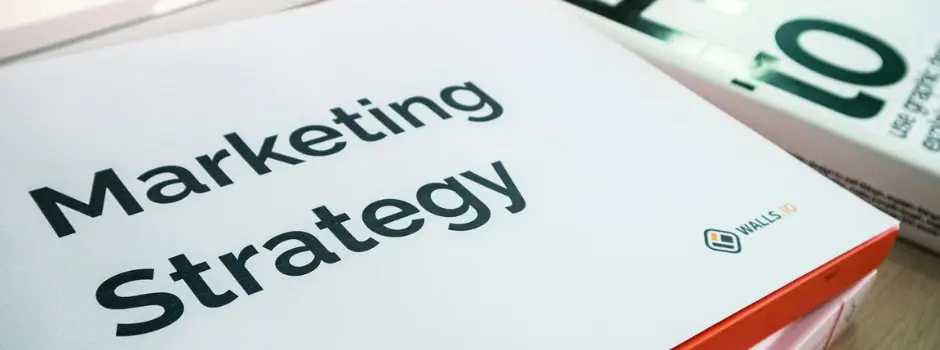
Paid Advertising Vs Content Marketing: A Detailed Comparison
Mar 10, 2025 7 Min Read 5795 Views
(Last Updated)
What’s the best way to generate leads? How to get maximum results from our marketing efforts while spending the least? If you’re a digital marketer, chances are that this question is a common acquaintance.
It’s always a hard and analytical choice between going organic and performing full-scale content marketing campaigns or going the paid route. What are the major differences between organic marketing and PPC advertising, if they both help generate leads and are as widely used as digital marketing experts?
Well, no worries! I have compiled a comprehensive list of differences that will help you choose between content marketing and paid advertising for your brand/organization. Go through them all, and read till the end to find out our verdict! Let’s get started now.
Table of contents
- Content Marketing Vs Paid Marketing: Key Differences
- What is Content Marketing?
- Key Aspects of Content Marketing
- Benefits of Content Marketing
- What is Paid Advertising?
- Key Components of Paid Marketing
- Benefits of Paid Marketing
- Content Marketing Vs Paid Marketing: Which One to Choose?
- Concluding Thoughts
- FAQs
- What is the key difference between content marketing and advertising?
- What is more effective than paid advertising?
- Why does content marketing beat paid advertising almost every time?
- How does paid advertising impact SEO?
- What are the disadvantages of paid advertising?
- How quickly can I see results with paid advertising compared to content marketing?
- Is content marketing suitable for all types of businesses?
- Can content marketing and paid advertising work together?
Content Marketing Vs Paid Marketing: Key Differences
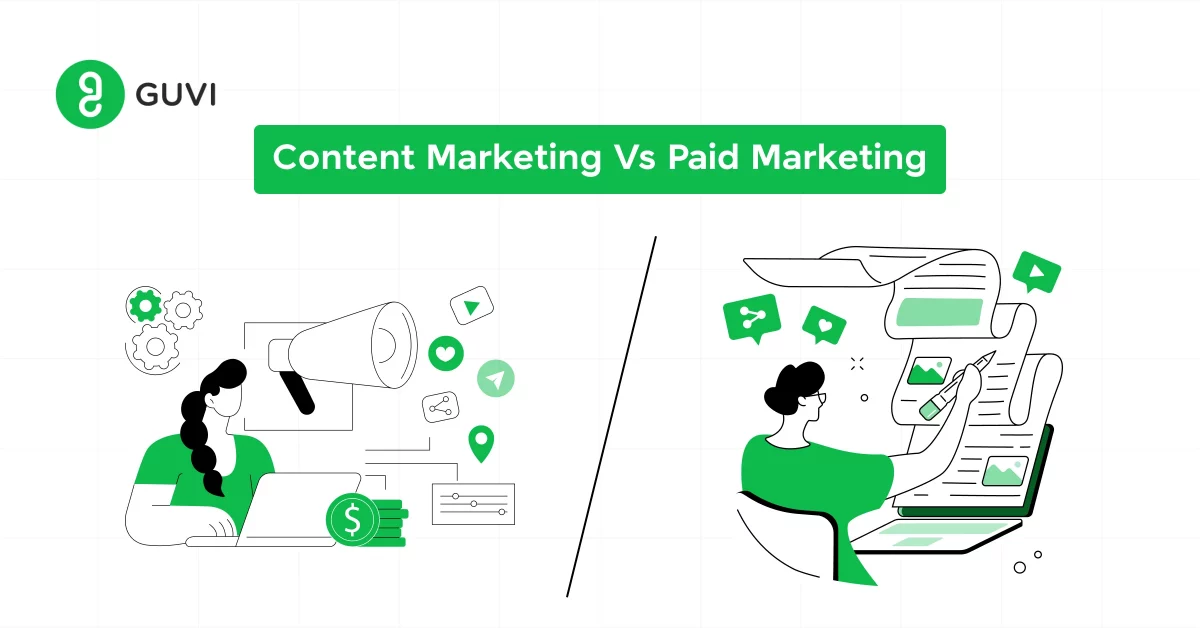
Here are the key differences between content marketing and paid ads marketing, across 25 different parameters or factors, which will help you gain a consolidated, yet comprehensive insight into the two types of digital marketing.
| Factor | Content Marketing | Paid Advertising |
|---|---|---|
| Definition (What are they?) | A strategic marketing approach focused on creating and distributing valuable, relevant, and consistent content to attract and retain a clearly defined audience — ultimately, to drive profitable customer action. | A model of internet marketing in which advertisers pay a fee each time one of their ads is clicked. Essentially, it’s a way of buying visits to your site, rather than attempting to “earn” those visits organically. |
| Examples (What Consists These Categories) | Blog posts, videos, infographics, eBooks, newsletters. | Pay-per-click (PPC) ads, display ads, social media ads, search engine marketing. |
| Investment Cost (Comparing the expenses associated with each approach) | Lower upfront costs compared to paid advertising, but requires a significant investment in time and resources over the long term to create and maintain content. | Pay-per-click (PPC) ads, display ads, social media ads, and search engine marketing. |
| ROI (Evaluating the ROI in terms of costs involved) | Potentially higher ROI in the long term as content continues to attract and engage audiences without ongoing costs. | Immediate but may decrease over time without continuous investment. ROI can be high but often requires constant optimization and expenditure. |
| Distribution Platforms (How and where it can be shared) | Owned and earned channels like company websites, blogs, social media profiles, and email lists. | Primarily paid platforms, including Google Ads, social media advertising platforms, and other digital ad networks. |
| Focus/Purpose (The main intention/task) | To educate, entertain, and engage the audience with the goal of building trust and authority, leading to conversions over time. The intent is to provide value and build a presence | To directly promote products or services and encourage immediate actions or conversions. The intent here is selling and promotion. |
| Reach (The number of people you can target and reach) | Potentially unlimited but depends on content virality, SEO, and sharing. | Can be vast and immediate, directly proportional to the advertising budget. |
| Engagement (How actively involved your audience is) | Typically higher as content marketing aims to create value for the audience, fostering more meaningful interactions. | Lower in comparison, as ads are often seen as intrusive. However, engagement can be optimized through targeting and creative strategies. |
| Conversion Rate (The percentage of audience members who take a desired action) | Can be higher due to the trust and value built over time, leading to more qualified leads. | May be quicker but not always as high quality as those from content marketing, depending on the targeting and appeal of the ad. |
| Longevity (How long your marketing efforts continue to have an impact) | Long-term impact as content can continue to attract and engage new audiences over time. | Short-term, with impact lasting as long as the advertising campaign runs. |
| Content Shelf Life (The relevance duration of your content or ads) | Long, especially for evergreen content that remains relevant and continues to drive traffic and engagement over time. | To educate, entertain, and engage the audience to build trust and authority, leading to conversions over time. |
| Brand Building (How well each method builds brand awareness) | Highly effective in building brand authority and loyalty over time through consistent, valuable content. | Can quickly increase brand visibility but may not contribute as significantly to building long-term brand authority. |
| Trustworthiness (The ability to build trust with your audience) | High, as content marketing focuses on providing value and establishing expertise. | Lower, as paid ads are often met with skepticism. |
| Tracking and Analysis (How easily you can measure performance) | Can be measured through analytics tools, but the impact on sales and conversions may take longer to become apparent. | Easier to measure direct impact on sales and conversions through detailed analytics provided by advertising platforms. |
| SEO Impact (Effects on search engine rankings and visibility) | Much significant, as high-quality content can improve search engine rankings and organic visibility. | None directly, though paid ads can increase traffic, potentially indirectly benefiting SEO through increased engagement metrics. |
| Personalization (Tailoring messages to your audience’s preferences) | High, as content can be created to address specific audience segments and stages in the buyer’s journey. | High, with advanced targeting options available through paid advertising platforms to reach specific demographics, interests, and behaviors. |
| Content Flexibility (How easily content can be used across different platforms) | Very flexible, with the ability to repurpose content across blogs, social media, email, and more. | Less flexible, as ad formats and creative may need to be tailored to specific platforms and guidelines. |
| Speed to Market (How quickly you can see results) | Slower, as building a content library and audience takes time. | Faster, as ads can be launched quickly and start generating results almost immediately. |
| Ease of Entry (The difficulty level of starting with each method) | Moderate to high, requiring content strategy, creation, and distribution capabilities. | Easier to start with a budget, but optimizing for effectiveness can be challenging. |
| Influence on Purchases (How each method affects buying decisions) | Strong, especially when content addresses customer needs and pain points throughout the buying journey. | Strong in the short term, especially for impulse buys or when offers are time-sensitive. |
| Scalability (How easily your efforts can be increased or decreased) | Scalable, but requires increasing content production and distribution efforts. | Highly scalable, with the ability to adjust budgets and campaigns quickly. |
| Creative Freedom (Control over the creative aspects) | High, with the ability to experiment and innovate with different types of content. | Varies by platform, but generally more restrictions on ad formats and content. |
| Regulatory Compliance (Meeting legal and platform guidelines) | Must comply with general web standards and copyright laws. | Must comply with specific advertising standards and regulations, which can be strict and vary by platform. |
| Pros (advantages) | Builds long-term relationships, improves SEO, cost-effective over time. | Immediate visibility, precise targeting, scalable. |
| Cons (disadvantages) | Easier to measure the direct impact on sales and conversions through detailed analytics provided by advertising platforms. | Takes time to see results, and requires consistent effort and content creation. |
Enrolling in GUVI’s Digital Marketing course can help you become an expert in the digital world, regardless of your level of marketing expertise. Learn the ins and outs of email marketing, social media marketing, content production, SEO, and more from professionals in the field. Through practical projects and real-world case studies, acquire job-ready skills with globally recognized certifications.
Instead, if you want to explore Marketing Research Techniques through a Self-paced course, try GUVI’s Marketing Research Techniques certification course.
Also Read | Watch Out For These Digital Marketing Trends or You’ll Miss Out!
What is Content Marketing?
Content marketing is a strategic approach focused on creating, publishing, and distributing content for a targeted audience online.
Unlike traditional marketing, which often interrupts the audience with direct sales pitches, content marketing seeks to attract, engage, and retain an audience by creating and sharing relevant articles, videos, podcasts, and other media.
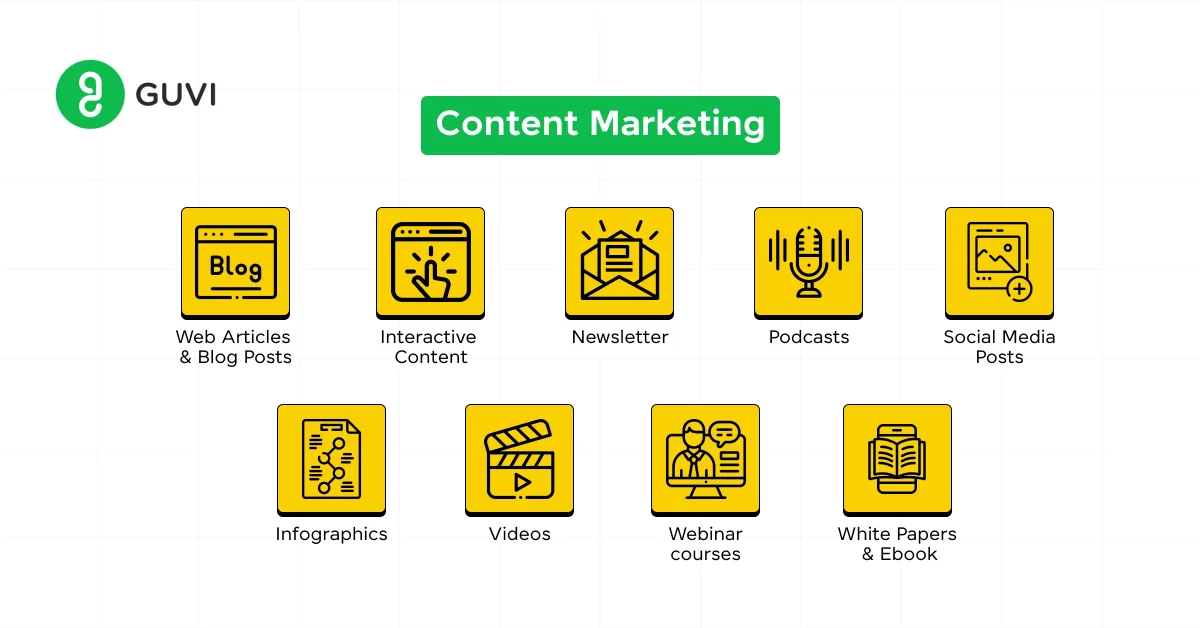
This approach establishes expertise, promotes brand awareness, and keeps your business top of mind when it’s time to buy what you sell.
Must Read: What is Content Marketing? Types, Uses, Strategy
Key Aspects of Content Marketing
- Audience-Centric Approach: The heart of content marketing lies in understanding the audience’s needs, preferences, and challenges. Businesses can build relationships with their audience beyond transactional interactions by delivering value through content that educates, entertains, or inspires
- Diverse Content Formats: Content marketing includes a lot of content formats such as blog posts, emails, newsletters, social media posts, videos, infographics, ebooks, reviews, and testimonials. Content marketing thrives on diversity. Each format serves different audience preferences and stages in the buyer’s journey, making the strategy versatile and effective.
- Applicable at All Marketing Stages: Content marketing is an extremely flexible medium that can serve across all marketing funnels or stages of a buyer’s journey.
- SEO Integration: A significant advantage of content marketing is its ability to improve search engine rankings. By incorporating keywords and producing valuable content, businesses can attract more organic traffic, enhancing visibility and credibility.
- Social Media Synergy: Content marketing and social media complement each other. Sharing content across social platforms increases reach and engagement, fostering community and driving traffic back to the company’s website.
- Analytics and Measurement: The effectiveness of content marketing can be tracked and analyzed through metrics such as engagement rates, website traffic, and conversion rates. This data-driven approach allows for continuous optimization.
Also Read | Excel at Data-Driven Marketing Just Like That
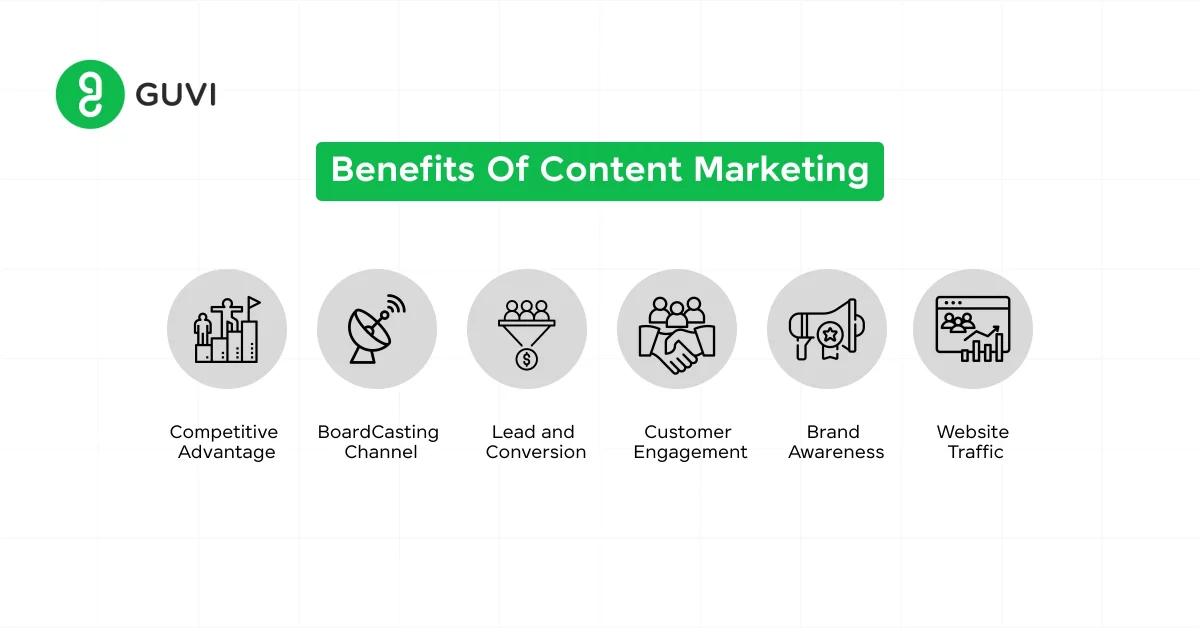
Benefits of Content Marketing
- Builds Trust and Loyalty: Regularly providing valuable content establishes a brand as a trustworthy authority in its field. This trust translates into loyalty and, ultimately, into sales.
- Enhances Brand Awareness: High-quality content has the potential to be shared widely, significantly increasing a brand’s visibility and attracting new customers.
- Cost-Effectiveness: Although content marketing requires an upfront investment in time and resources, it is more cost-effective in the long run compared to paid advertising, due to its sustainable nature.
- Supports Other Digital Marketing Strategies: Content marketing is the backbone of email marketing, social media marketing, and SEO, providing the content that drives these other digital marketing efforts.
Content marketing offers a solution by enabling brands to demonstrate their expertise and differentiate themselves. Its popularity stems from its effectiveness in attracting and retaining customers, and playing a crucial role in converting leads into loyal customers. ]
What is Paid Advertising?
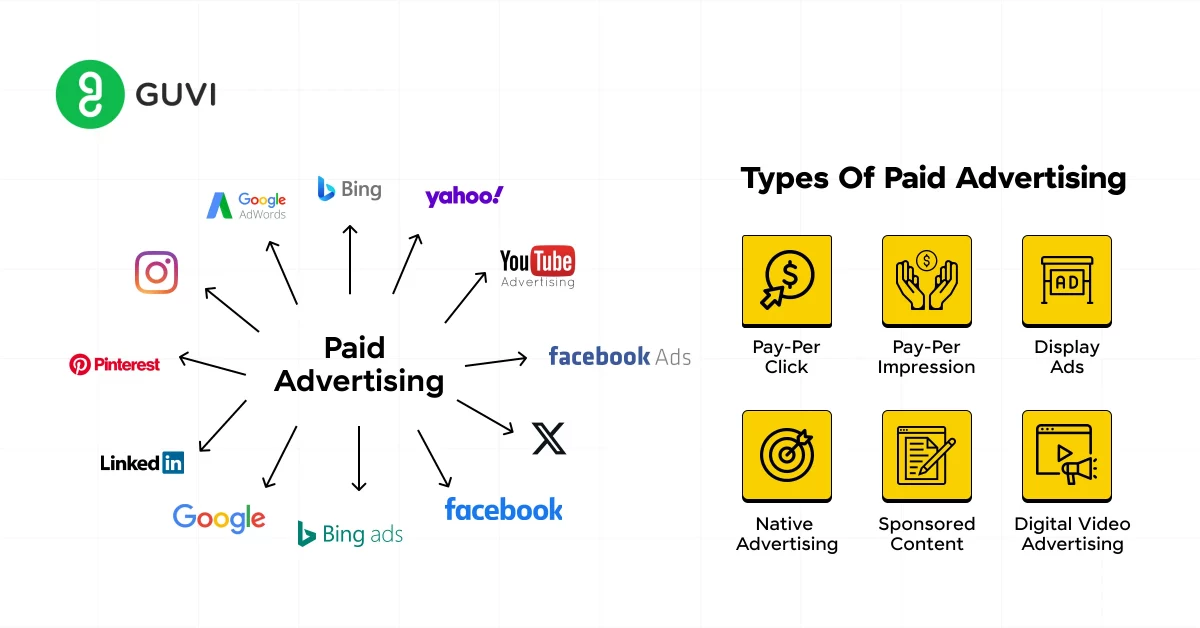
Paid marketing, also known as paid advertising, encompasses various forms of online advertising where businesses pay to display their ads on digital platforms.
These ads can appear on search engines, social media networks, websites, and other digital spaces, offering precise targeting options based on demographics, interests, behaviors, and more.
The essence of paid marketing is to buy visibility for your brand or products, contrasting with organic strategies that focus on earning attention over time.
Must Know The Top 15 Most Important SEO Ranking Factors
Key Components of Paid Marketing
- Pay-Per-Click (PPC) Advertising: PPC ads are a staple of paid marketing, where advertisers pay each time a user clicks on their ads. Search engine advertising through Google Ads is a prime example, allowing businesses to appear above organic search results for specific keywords.
- Display Advertising: These ads appear on websites across the internet, showcasing visuals such as banners or videos to attract the viewer’s attention and encourage clicks.
- Social Media Advertising: Platforms like Facebook, Instagram, LinkedIn, and Twitter offer extensive advertising options, enabling brands to reach users based on detailed targeting criteria.
- Remarketing: A powerful strategy that targets users who have previously interacted with your website or mobile app, remarketing ads remind and encourage them to return and complete a purchase or action.
- Influencer Marketing: While not traditional paid advertising, paying influencers to promote your products taps into their audience, leveraging their trust and authority.
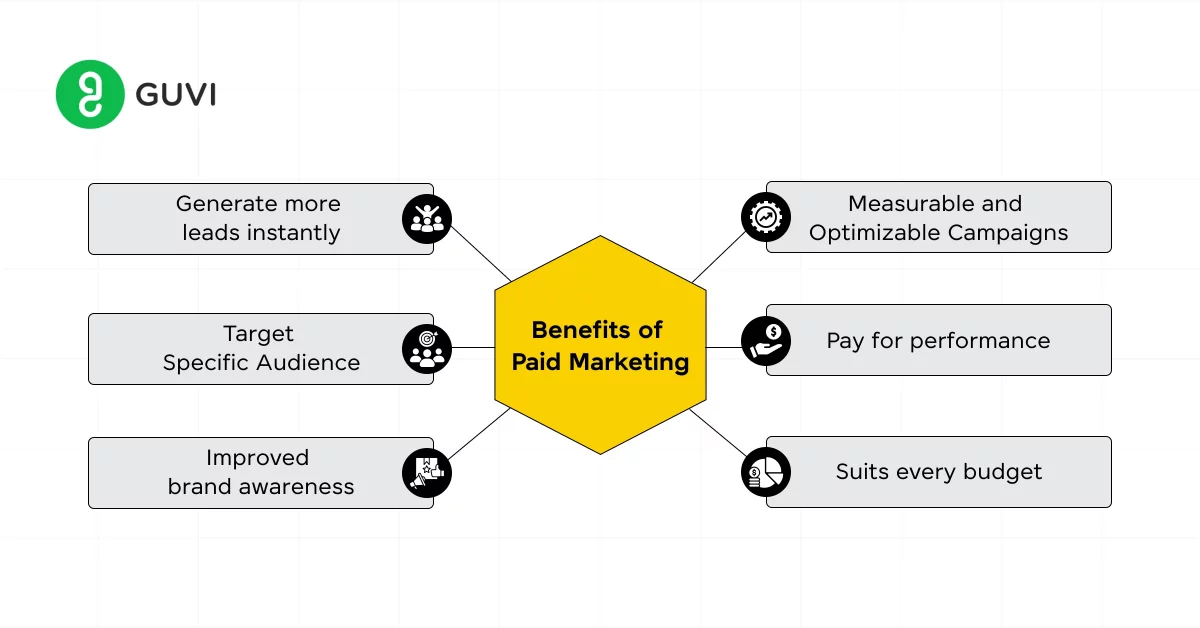
Benefits of Paid Marketing
- Immediate Visibility: Paid marketing can place your brand at the forefront quickly, ideal for new product launches or time-sensitive promotions.
- Precise Targeting: Advanced targeting options ensure your ads are seen by your ideal audience, increasing the likelihood of conversion.
- Scalability: Easily adjust your advertising spend based on performance and budget, allowing for flexible marketing strategies.
- Measurable Results: Digital platforms provide detailed analytics, making it straightforward to measure ROI and adjust campaigns for optimal performance.
- Enhanced Brand Exposure: Paid ads extend your reach beyond organic limitations, introducing your brand to a wider audience.
Paid marketing has become a popular choice for businesses of all sizes given its ability to generate quick results, coupled with the sophistication of targeting and analytics, which allows for highly effective marketing campaigns.
Also Read: 10 Best Digital Marketing Projects
Content Marketing Vs Paid Marketing: Which One to Choose?
Choosing between content marketing and paid marketing hinges on your business goals, budget, and timeline.
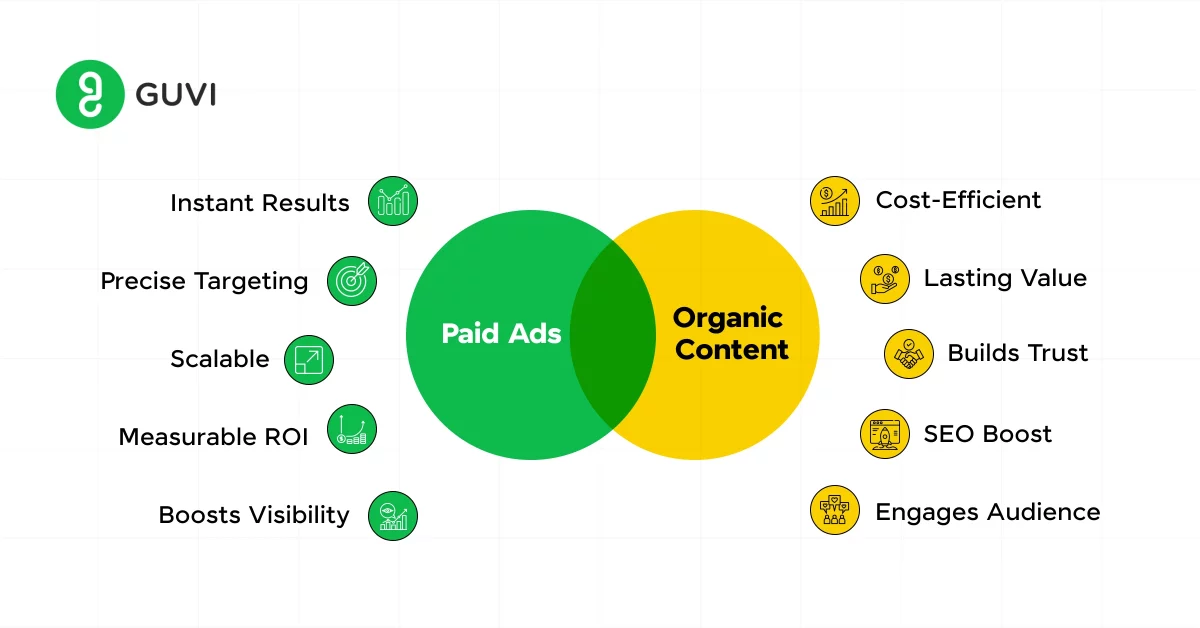
Content marketing excels in building long-term relationships with your audience through valuable, relevant content, enhancing brand trust and loyalty over time. It’s cost-effective in the long run, boosting your SEO and establishing your brand as an authority in your industry.
On the flip side, paid marketing offers immediate visibility and precise targeting, making it ideal for quick results and specific campaigns. It allows for scalable strategies with measurable outcomes, though it requires a continuous investment to maintain visibility.
It should also be considered that the rise of ad blockers and the public’s growing aversion to traditional advertising have made content marketing even more critical. It offers a subtler, more engaging way to connect with audiences tired of overt advertisements.
Yet, we can’t ignore the fact that organic reach alone is often insufficient to achieve significant visibility in the increasingly competitive digital space. Paid marketing complements organic strategies, ensuring a comprehensive approach to digital marketing.
The most effective digital marketing plan often lies in a balanced, integrated approach that leverages the strengths of both to achieve your marketing goals. So, it all boils down to your purpose and the kind of result you seek to achieve.
Join GUVI’s Digital Marketing Course to kickstart your journey in this exciting field. Gain expertise in ChatGPT, WordPress, Meta Business Suite, Google Analytics, Youtube Analytics, Google Ads Manager, and more. Master essential skills in SEO, social media marketing, email marketing, content creation, and digital advertising tactics to excel in the Digital Marketing industry.
Alternatively, if you want to explore Marketing Research Techniques through a Self-paced course, try GUVI’s Marketing Research Techniques certification course.
Concluding Thoughts
That was our take on the major differences between content marketing and paid marketing across various factors.
The decision isn’t necessarily about choosing one over the other but rather understanding how each can serve your marketing objectives. For sustained growth and brand building, content marketing is indispensable. For immediate reach and targeting, paid marketing is unmatched.
By understanding the unique benefits and applications of both approaches, businesses can craft a holistic marketing strategy that combines the long-term relationship-building of content marketing with the immediate impact and precision of paid marketing.
Also Read: How to Learn Digital Marketing
FAQs
The key difference lies in their approach: content marketing focuses on creating and distributing valuable, relevant content to attract and retain a targeted audience, while advertising involves paying for space to promote products or services directly.
Content marketing can be more effective than paid advertising in the long term because it builds a deeper relationship with the audience through valuable content, enhancing brand trust and loyalty, which are crucial for sustained business growth.
Content marketing often beats paid advertising because it provides lasting value to the audience, establishing trust and authority for the brand. This approach leads to higher engagement, better SEO, and more sustainable growth compared to the temporary visibility paid advertising offers.
Paid advertising does not directly impact SEO rankings. However, it can indirectly benefit SEO through increased traffic and improved user engagement metrics, which are signals of relevance and quality to search engines.
The disadvantages of paid advertising include the ongoing cost required to maintain visibility, potential ad fatigue among the audience, and lower trust compared to organic content. Additionally, its effectiveness can diminish over time without continuous optimization and investment.
Paid advertising can yield immediate results by driving traffic and conversions as soon as campaigns are launched. In contrast, content marketing often requires more time to build momentum and see significant results, as it focuses on establishing long-term relationships with the audience.
Yes, content marketing is suitable for all types of businesses, regardless of size or industry. It’s a versatile strategy that can be tailored to meet the specific needs and goals of any business, offering a cost-effective way to engage and retain customers over time.
Yes, content marketing and paid advertising can work together effectively. Paid advertising can amplify the reach of content marketing efforts, driving traffic to high-quality content and enhancing overall marketing strategy through a synergistic approach.

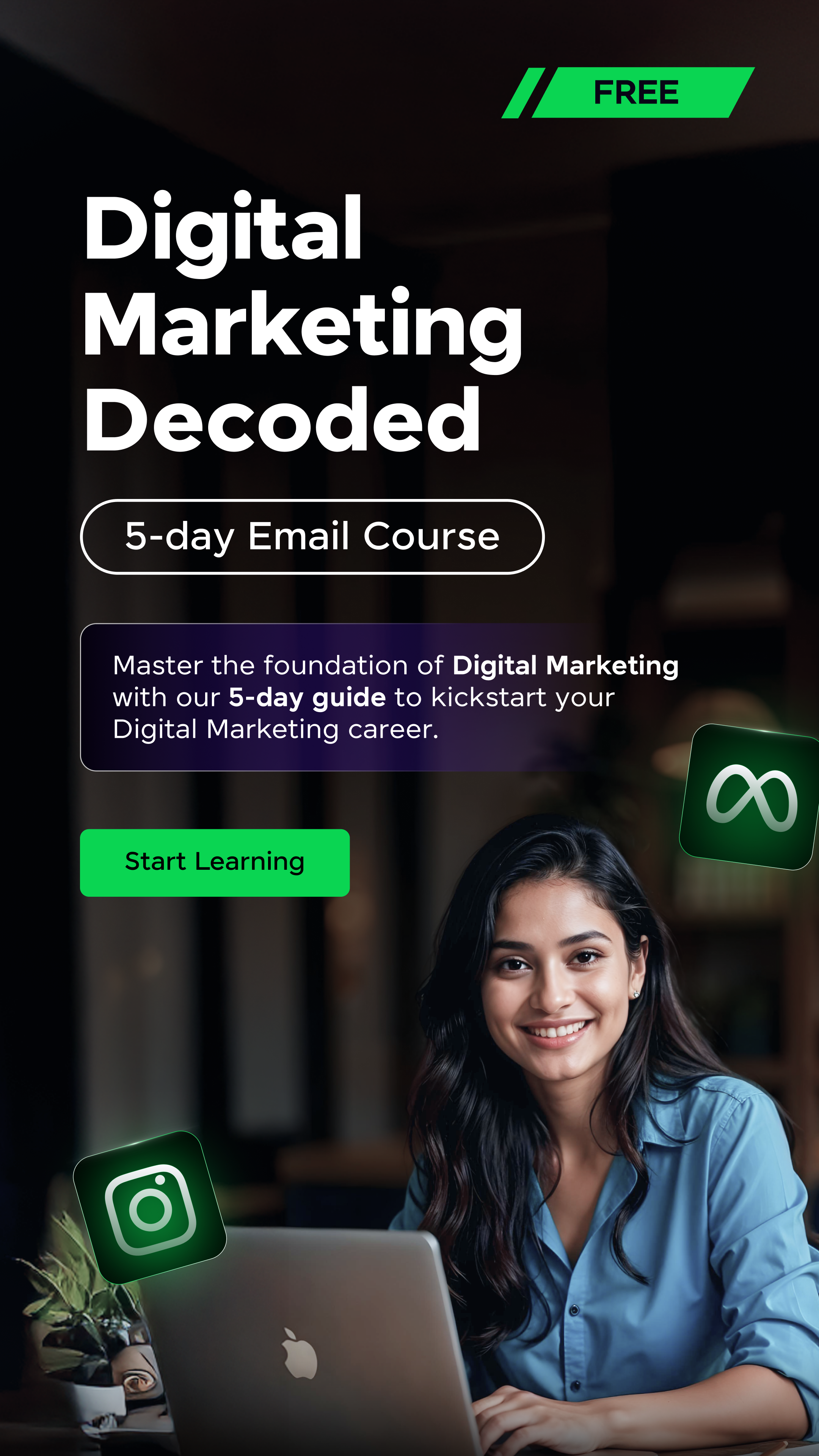


















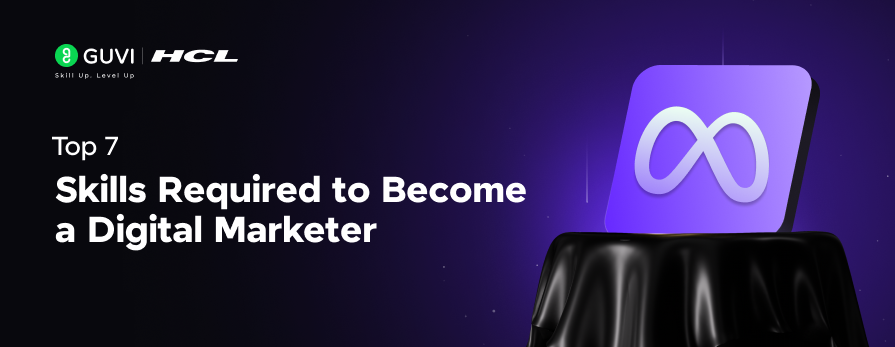
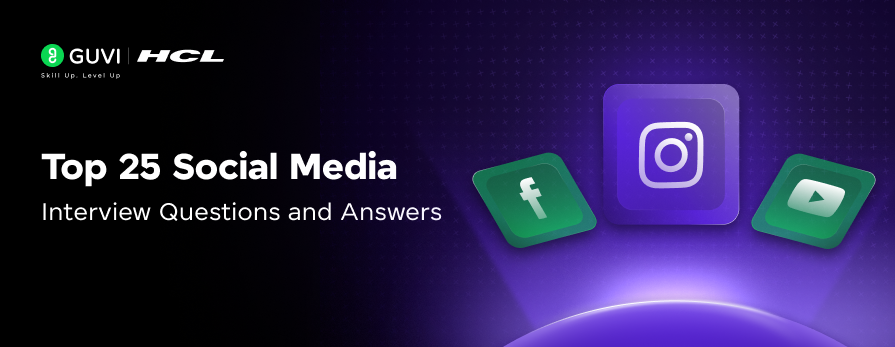
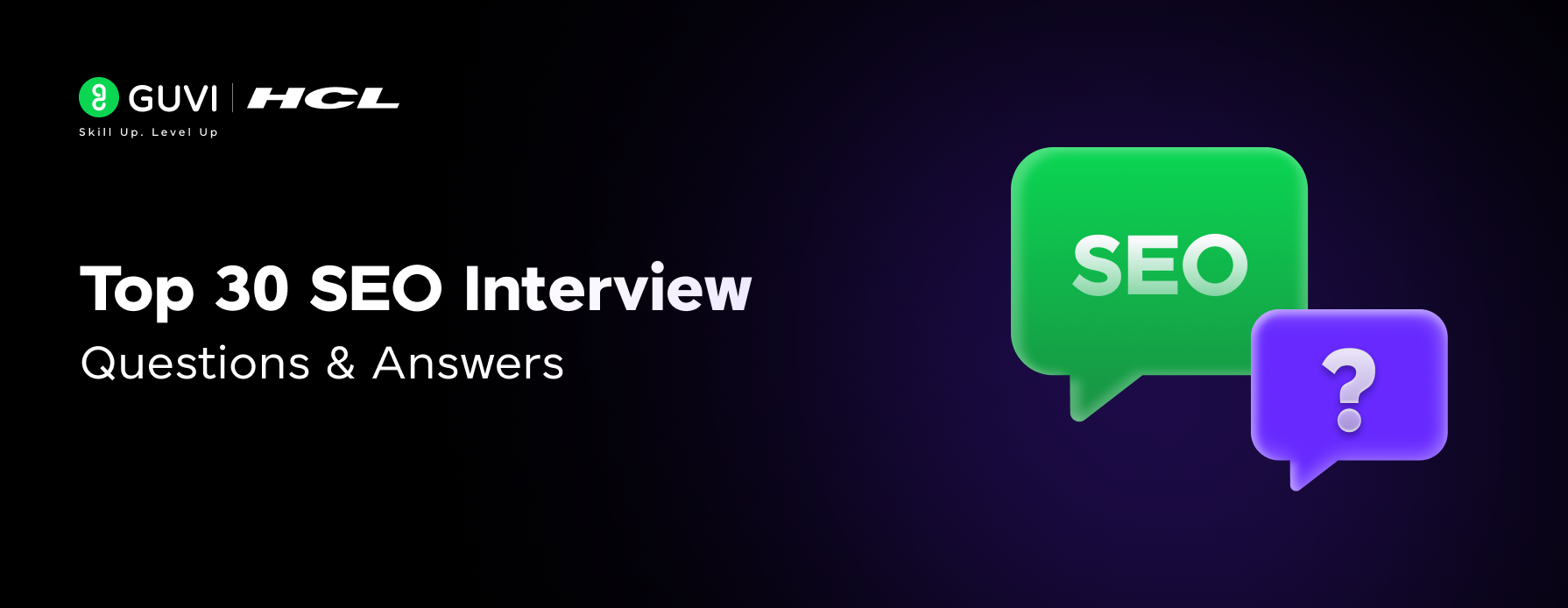
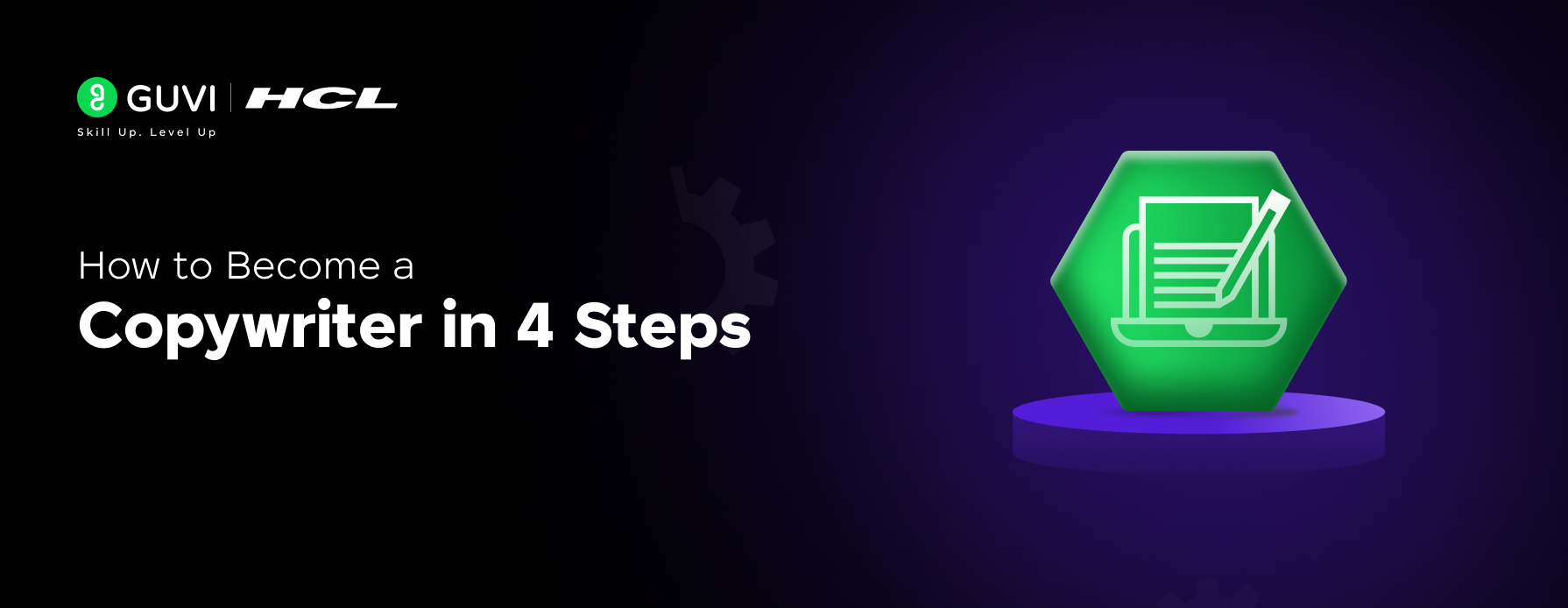
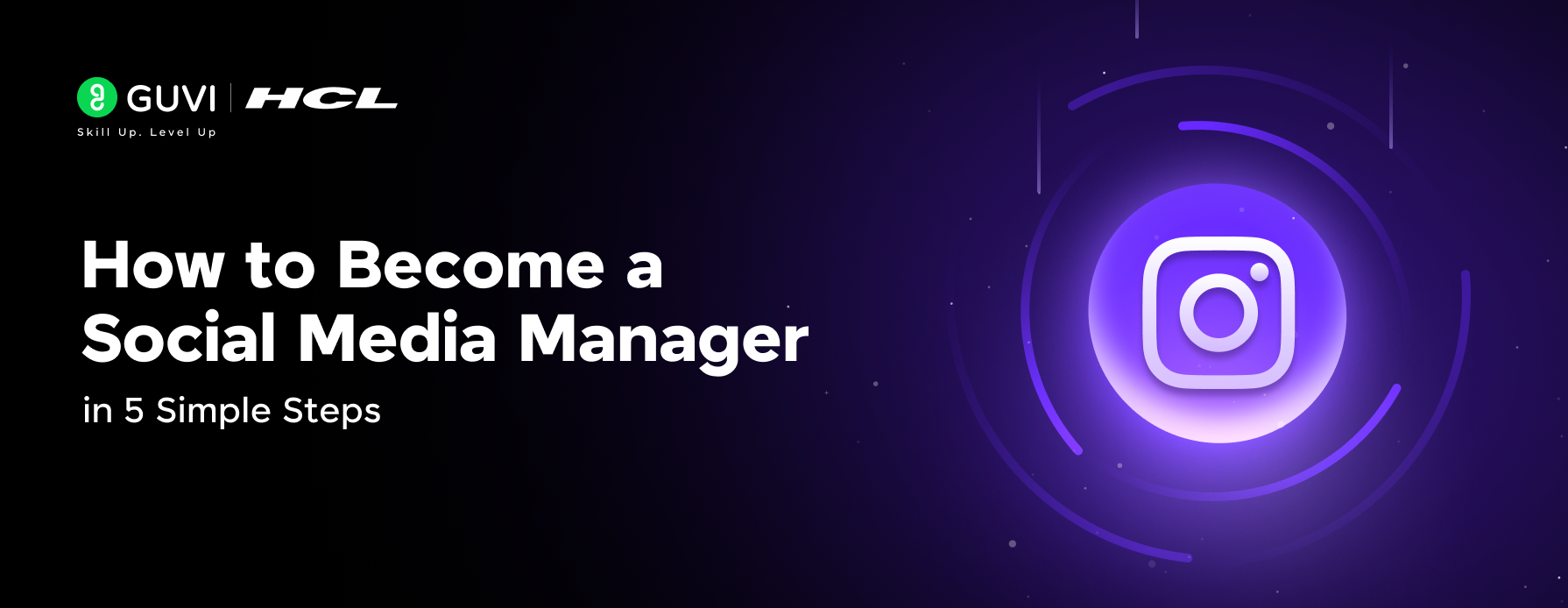
![How to Switch from Sales to Digital Marketing: A Beginner's Guide [2025] 13 sales to digital marketing](https://www.guvi.in/blog/wp-content/uploads/2025/01/How-to-switch-your-career-from-Sales-to-Digital-Marketing.png)
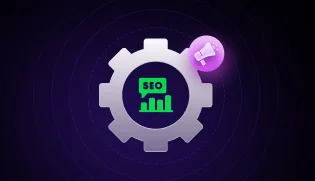



Did you enjoy this article?